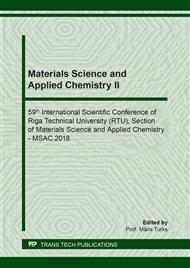[1]
S. Chen, Q. Yue, B. Gao, Q. Li, X. Xu, K. Fu, Adsorption of hexavalent chromium from aqueous solution by modified corn stalk: A fixed-bed column stud, BioresourceTechnology. 113 (2012) 114-120.
DOI: 10.1016/j.biortech.2011.11.110
Google Scholar
[2]
M. EvyAliceAbigail, M.S. Samuel, R. Chidambaram, Hexavalent chromium biosorption studies using Penicillium griseofulvum MSR1 a novel isolate from tannery effluent site: Box–Behnken optimization, equilibrium, kinetics and thermodynamic studies, J. of the Taiwan Institute of Chemical Engineers. 49 (2015) 156-164.
DOI: 10.1016/j.jtice.2014.11.026
Google Scholar
[3]
C.A. Demarchi, A. Debrassi, J.D. Magro, N. Nedelko, A. Slawska-Waniewska, P. Dluzewski, J.M. Greneche, C.A. Rodrigues, Adsorption of Cr(VI) on crosslinked chitosan–Fe(III) complex in fixed-bed Systems, Journal of Water Process. 7 (2015) 141-152.
DOI: 10.1016/j.jwpe.2015.05.003
Google Scholar
[4]
M.E.R. Carmona, M.A. Pereira da Silva, S.G. Ferreira Leite, O.H.V. Echeverri, C. Ocampo-Lopez, Packed bed redistribution system for Cr(III) and Cr(VI) biosorption by Saccharomyces cerevisiae, J. of the Taiwan Institute of Chemical Engineers. 43 (2012) 428-432.
DOI: 10.1016/j.jtice.2011.12.002
Google Scholar
[5]
S. Sugashini, K.M.M. Sheriffa Begum, Performance of ozone treated rice husk carbon (OTRHC) for continuous adsorption of Cr(VI) ions from synthetic effluent, J. Environmental Chemical Engineering. 1 (2013) 79-85.
DOI: 10.1016/j.jece.2013.04.003
Google Scholar
[6]
N. Rangabhashiyam, N. Selvaraju, Evaluation of the biosorption potential of a novel Caryota urens inflorescence waste biomass for the removal of hexavalent chromium from aqueous solutions, J. of the Taiwan Institute of Chemical Engineers. 47 (2015) 59-70.
DOI: 10.1016/j.jtice.2014.09.034
Google Scholar
[7]
R.M. Agarwal and K. Singh, Heavy metal removal from wastewater using various adsorbents, J. of Water Reuse and Desalination. (2017).
DOI: 10.2166/wrd.2016.104
Google Scholar
[8]
A. Iddou and M.S. Ouali, Waste-activated sludge (WAS) as Cr(III) sorbent biosolid from wastewater effluent, Colloids Surfaces B Biointerfaces. 66 (2008) 240-245.
DOI: 10.1016/j.colsurfb.2008.06.018
Google Scholar
[9]
N. Noureddine, S. Benhammadi, F. Kara, H. Aguedal, A. Iddou, T. Juhna, Purification of Contaminated Water with Chromium (VI) using Pseudomonas aeruginosa, Key Eng. Mater. 721 (2017) 143-148.
DOI: 10.4028/www.scientific.net/kem.721.143
Google Scholar
[10]
H.C. Thomas, Heterogeneous ion exchange in a flowing system, J. Am. Chem. 66 (1944) 1664-1666.
Google Scholar
[11]
G.S. Bohart, E.Q. Adams, Some aspects of the behaviour of the charcoal with respect chlorine, J. Am. Chem. Soc. 42 (1920) 523-544.
DOI: 10.1021/ja01448a018
Google Scholar
[12]
R.M. Clark, Evaluating the cost and performance of field-scale granular activated carbon systems, Environ. Sci. Technol. 21 (1987) 573-580.
DOI: 10.1021/es00160a008
Google Scholar
[13]
G. Yan, T. Viraraghavan, M. Chen, A new model for heavy metal removal in a biosorption column, Adsorption Science and Technology. 19 (2001) 25-43.
DOI: 10.1260/0263617011493953
Google Scholar
[14]
S. Rangabhashiyam, N. Selvaraju, Evaluation of the biosorption potential of a novel Caryota urens inflorescence waste biomass for the removal of hexavalent chromium from aqueous solutions, J. Taiwan Inst. Chem. Eng. 47 (2014) 59-70.
DOI: 10.1016/j.jtice.2014.09.034
Google Scholar
[15]
D.Z. Husein, T. Al-Radadi, E.Y. Danish, Adsorption of phosphate using alginate-/zirconium-grafted newspaper pellets: fixed-bed column study and application, Arab. J. Sci. Eng. 42 (2016) 1399-1412.
DOI: 10.1007/s13369-016-2250-z
Google Scholar
[16]
K.W. Jung, T.U. Jeong, J.W. Choi, K.H. Ahn, S.H. Lee, Adsorption of phosphate from aqueous solution using electrochemically modified biochar calcium-alginate beads: batch and fixed-bed column performance, Bioresour. Technol. 244 (2017) 23-32.
DOI: 10.1016/j.biortech.2017.07.133
Google Scholar
[17]
H. Esfandian, A. Samadi-Maybodi, B. Khoshandam, M. Parvini, Experimental and CFD modeling of diazinon pesticide removal using fixed bed column with Cu-modified zeolite nanoparticle, Journal of the Taiwan Institute of Chemical Engineers. 75 (2017) 164-173.
DOI: 10.1016/j.jtice.2017.03.024
Google Scholar
[18]
P. Suksabye, P. Thiravetyan, W. Nakbanpote, Column study of chromium (VI) adsorption from electroplating industry by coconut coir pith, J. Hazard. Mater. 160 (2008) 56-62.
DOI: 10.1016/j.jhazmat.2008.02.083
Google Scholar
[19]
A.P. Lim, A.Z. Aris, Continuous fxed-bed column study and adsorption modeling: Removal of cadmium(II) and lead(II) ions in aqueous solution by dead calcareous skeletons, Biochemical Engineering Journal. 87 (2014) 50-61.
DOI: 10.1016/j.bej.2014.03.019
Google Scholar
[20]
S. Chen, Q. Yue, B. Gao, Q. Li, X. Xu, K. Fu, Adsorption of hexavalent chromium from aqueous solution by modified corn stalk: A fixed-bed column study, Bioresource Technology. 113 (2012)114-120.
DOI: 10.1016/j.biortech.2011.11.110
Google Scholar
[21]
A.H. Sulaymon, A.A.H. Faisal, Q.M. Khaliefa, Cement kiln dust (CKD)-filter sand permeable reactive barrier for the removal of Cu(II) and Zn(II) from simulated acidic groundwater, Journal of Hazardous Materials. 297 (2015) 160-172.
DOI: 10.1016/j.jhazmat.2015.04.061
Google Scholar


